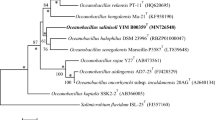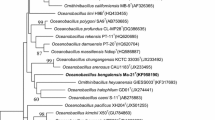Abstract
A bacterial strain, designated YIM 98839T, was isolated from the hypersaline sediment of Aiding Lake in Xinjiang province, North-West China. The strain was Gram-stain-positive, motile, aerobic, produced oval subterminal or central endospores in swollen sporangia. The whole-cell hydrolysates contain meso-diaminopimelic acid as the diagnostic cell-wall diamino acid. Galactose, fucose and ribose are the major whole-cell sugars. The phospholipids are diphosphatidylglycerol, phosphatidylglycerol and one unknown phospholipid. The predominant menaquinone is MK-7. The major fatty acids are anteiso-C15:0, anteiso-C17:0 and iso-C15:0. The DNA G + C content of the type strain is 37.0 mol%. Phylogenetic analysis indicated that the isolate belongs to the genus Oceanobacillus. However, it differed from its closest relative, Oceanobacillus limi H9BT in many physiological characteristics. Moreover, the DNA–DNA relatedness values between the novel isolate and the relative type strain was 20.2%. Based on comparative analysis of polyphasic taxonomic data, strain YIM 98839T represents a novel species of the genus Oceanobacillus, for which the name Oceanobacillus halotolerans sp. nov. is proposed. The type strain is YIM 98839T (= CGMCC 1.17002T = KCTC 43140T).

Similar content being viewed by others
References
Amoozegar MA, Bagheri M, Makhdoumi-Kakhki A, Didari M, Schumann P, Spröer C, Sánchez-Porro C, Ventosa A (2014) Oceanobacillus limi sp. nov., a moderately halophilic bacterium from a salt lake. Int J Syst Evol Microbiol 64:1284–1289
Baron EJ, Finegold SM (1990) Bailey and scott’s diagnostic microbiology, 8th edn. Mosby, St. Louis
Collins MD, Pirouz T, Goodfellow M, Minnikin DE (1977) Distribution of menaquinones in actinomycetes and corynebacteria. J Gen Microbiol 100:221–230
Collins MD, Jones D (1980) Lipids in the classification and identification of coryneform bacteria containing peptidoglycans based on 2,4-diaminobutyric acid. J Appl Bacteriol 48:459–470
Felsenstein J (1981) Evolutionary trees from DNA sequences: a maximum likelihood approach. J Mol Evol 17:368–376
Felsenstein J (1985) Confidence limits on phylogenies: an approach using the bootstrap. Evolution 39:783–791
Fitch WM (1971) Toward defining the course of evolution: minimum change for a specific tree topology. Syst Zool 20:406–416
Harrigan WF, McCance ME (1976) Laboratory methods in food and dairy microbiology. Academic Press, London
Hasegawa T, Takizawa M, Tanida S (1983) A rapid analysis for chemical grouping of aerobic actinomycetes. J Gen Appl Microbiol 29(4):319–322
Kumar S, Stecher G, Tamura K (2016) MEGA7: molecular evolutionary genetics analysis version 7.0 for bigger datasets. Mol Biol Evol 33:1870–1874
Lechevalier MP, Lechevalier HA (1970) Chemical composition as a criterion in the classification of aerobic actinomycetes. Int J Syst Bacteriol 20:435–443
Li WJ, Xu P, Schumann P, Zhang YQ, Pukall R, Xu LH, Stackebrandt E, Jiang CL (2007) Georgenia ruanii sp. nov., a novel actinobacterium isolated from forest soil in Yunnan (China), and emended description of the genus Georgenia. Int J Syst Evol Microbiol 57:1424–1428
Lu J, Nogi Y, Takami H (2001) Oceanobacillus iheyensis gen. nov., sp. nov., a deep-sea extremely halotolerant and alkaliphilic species isolated from a depth of 1050 m on the Iheya Ridge. FEMS Microbiol Lett 205:291–297
Meier-Kolthoff JP, Auch AF, Klenk HP, Göker M (2013) Genome sequence-based species delimitation with confidence intervals and improved distance functions. BMC Bioinfor 14:60
Minnikin DE, Collins MD, Goodfellow M (1979) Fatty acid and polar lipid composition in the classification of Cellulomonas, Oerskovia and related taxa. J Appl Bacteriol 47:87–95
Murray RG, Doetsch RN, Robinow CF (1994) Determinative and cytological light microscopy. In: Gerhardt P, Murray RG, Wood WA, Krieg NR (eds) Methods for general and molecular bacteriology. American Society for Microbiology, Washington DC, pp 21–41
Saitou N, Nei M (1987) The neighbor-joining method: a new method for reconstructing phylogenetic trees. Mol Biol Evol 4:406–425
Smibert R, Krieg NRM (1994) Phenotypic characterization. In: Gerhardt P, Murray RG, Wood WA, Krieg NR (eds) Methods for general and molecular bacteriology. American Society for Microbiology, Washington DC, pp 607–654
Tamaoka J, Katayama-Fujimura Y, Kuraishi H (1983) Analysis of bacterial menaquinone mixtures by high performance liquid chromatography. J Appl Bacteriol 54:31–36
Tang SK, Wang Y, Chen Y, Lou K, Cao LL, Xu LH, Li WJ (2009) Zhihengliuella alba sp. nov., and emended description of the genus Zhihengliuella. Int J Syst Evol Microbiol 59:2025–2032
Thompson JD, Gibson TJ, Plewniak F, Jeanmougin F, Higgins DG (1997) The CLUSTAL_X windows interface: flexible strategies for multiple sequence alignment aided by quality analysis tools. Nucleic Acids Res 25:4876–4882
Wayne LG, Brenner DJ, Colwell RR, Grimont PAD, Kandler O, Krichevsky MI, Moore LH, Moore WEC, Murray RGE (1987) International committee on systematic bacteriology. report of the ad hoc committee on reconciliation of approaches to bacterial systematics. Int J Syst Bacteriol 37:463–464
Yu C, Yu S, Zhang Z, Li Z, Zhang XH (2014) Oceanobacillus pacificus sp. nov., isolated from a deep-sea sediment. Int J Syst Evol Microbiol 64:1278–1283
Xu P, Li WJ, Tang SK, Zhang YQ, Chen GZ, Chen HH, Xu LH, Jiang CL (2005) Naxibacter alkalitolerans gen. nov., sp. nov., a novel member of the family ‘Oxalobacteraceae’ isolated from China. Int J Syst Evol Microbiol 55:1149–1153
Yoon SH, Ha SM, Kwon S, Lim J, KimY SH, Chun J (2017) Introducing EzBioCloud: a taxonomically united database 16S rRNA and whole genome assemblies. Int J Syst Evol Microbiol 67:1613–1617
Acknowledgements
This study was performed with the support of the National Natural Science Foundation of China (31760003 and 31500011) and the Natural Science Foundation of Yunnan Province (2017FB039).
Author information
Authors and Affiliations
Corresponding authors
Additional information
Communicated by Erko Stackebrandt.
Publisher's Note
Springer Nature remains neutral with regard to jurisdictional claims in published maps and institutional affiliations.
The NCBI GenBank accession number for the 16S rRNA gene sequence of strain YIM 98839T is MN251020. The draft whole genome sequence for YIM 98839T has been deposited at DDBJ/ENA/GenBank under accession number PRJNA586765.
Electronic supplementary material
Below is the link to the electronic supplementary material.
Rights and permissions
About this article
Cite this article
Zhu, WY., Yang, L., Shi, YJ. et al. Oceanobacillus halotolerans sp. nov., a bacterium isolated from salt lake in Xinjiang province, north-west China. Arch Microbiol 202, 1545–1549 (2020). https://doi.org/10.1007/s00203-020-01865-4
Received:
Revised:
Accepted:
Published:
Issue Date:
DOI: https://doi.org/10.1007/s00203-020-01865-4




